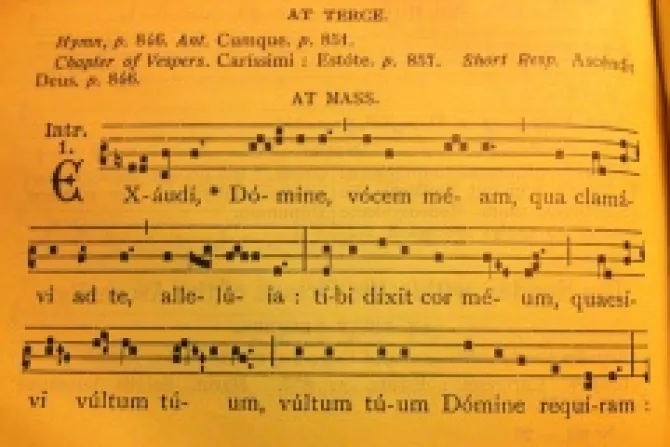Denver, Colorado, May 9, 2013 / 03:03 am
Gregorian chant is freely available and a music of the people – not the domain of a stuffy, Catholic elite as it is often perceived, says a music scholar from Alabama.
"You can listen to it, download perfect editions, you can make your own editions, it's freely shared with the world," said Jeffrey Tucker, managing editor of "Sacred Music" and founder of "The Chant Café" blog.
Chant is "distributed on an open source platform" and "available to everybody – just like the Gospel, and just like the graces of God," he said in a May 8 interview with CNA.
The "free culture" aspect of chant is the subject of a paper Tucker will discuss at the Sacra Liturgia 2013 conference in Rome this June. His topic, "The Liturgical Aposto late and the Internet," will survey how chant suffered in the early 20th century when it was copyrighted, and how it has experienced a resurgence in recent years thanks to entering the commons.
"You went through essentially 1900 years of Christianity with the chant being an open source framework, an open source form of music that flourished in the first millennium through the oral tradition of copying, imitation, and free use," Tucker explained.
Chant was then was built upon during the second millennium with organum, polyphony, the great works of the Renaissance, and then further inspired the Classical composers, he said.
By the 20th century, however, chant had fallen into dis-use in most parishes. In 1903 Pius X, who sought "to restore all things in Christ," issued a document by which "he wanted a big push for chant to become truly universalized throughout the Catholic world."
Tucker's recent research, which he will highlight at Sacra Liturgia conference in Rome, shows that Pius X wanted Gregorian chant to be "a free gift to the whole Church, and that any publisher should be free to publish it."
Yet when a new edition of the Graduale Romanum was published in 1908, it was copyrighted. This was a "catastrophic change" in chant's status, Tucker said.
For next 50 years, it became "a kind of proprietary product, held by one institution" with an elite controlling it. "It was all kind of stifling, really," and by the mid-60s Catholic musicians were "fed up."
By the 1960s chant was perceived as "owned," and "a kind of corporate product." Churchgoer's wanted something "more free and authentic...and that's a big part of why the folk tradition appealed to that generation."
Yet today, the situations have reversed, Tucker remarked. In the present-day liturgical environment, "you have exactly the opposite having happened."
"All the successor music to the folk music that came of age in the 60s, is heavily corporate-controlled, heavily copyrighted, and under proprietary distribution."
"You have to sign up and be a member, and your parish has to pay ghastly fees for the right to sing the music, and on and on and on," he said.
"It's more or less in the same position that chant was in in the 1950s, whereas the chant is now completely open source."
Five years ago, Tucker was responsible for putting the first big edition of Gregorian chant online, noting that the internet has greatly contributed to the dissemination of chant and its open source status.
"In the course of a year, we saw the usual pattern take place: derivative works were created, new software platforms emerged, new fonts came to be created, and it seems incredible that that was only five years ago, because now you can download an app for your digital device."
The development of apps, such as Liber Pro, are demonstrative of the "free culture" and "folk" nature of chant, and "how the open source Liber (Usualis) is being used," Tucker said.
"All these derivative works came about – recordings were newly posted, now all the chant books are online, you can go to YouTube and listen to any chant, multiple recordings and multiple interpretations, and new chant books came to be written, thanks to the fonts that were written, again on an open source basis."
"So this thing that used to seem remote, snooty, unfamiliar, spooky, and weird, is now super familiar and available in many different formats, for all people in the world."
Tucker said that having chant at parishes "changes people's liturgical experience dramatically."
"When you show up at Mass, would you rather hear a chanted version of a scriptural antiphon that speaks directly to the liturgical year and season and day – all the way down to the precise reason you're there that day – or do you want to hear 'Gather us in' again?"
"The changes make a big difference in the way people experience the faith, week to week."



